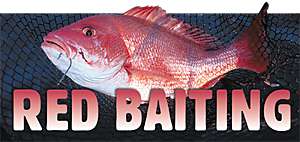|
Red Baiting

By Chester Moore, Jr.
Page 2
Davis likes to anchor up-current
of a given piece of structure and fall back across it. The preferred
method when fishing these areas is to use a typical bottom rig
with either squid or Spanish sardine rigged on two circle hooks.
"A lot of times, you'll
have a strong current and you need to get the bait down to the
structure," Davis adds. "When you're fishing rigs, you've
got a little more leeway, but presenting a bait 5 feet in one
direction or another can make all of the difference in the world."
Just north of Galveston/Freeport
is Sabine Pass, an area that probably receives less pressure than
any spot on the Texas Coast. The fishing here is based around
the fertile Sabine Bank, a plateau that rises off of the Gulf's
floor and forms a shallow flat that parallels both sides of the
ship channel that leads out of the Sabine jetties.
This 25- to 40-foot deep flat
attracts an awesome amount of baitfish and is dotted by hundreds
of platforms and wrecks that attract some monster red snapper.
Sabine guide Capt. Todd Bryson of Complete Sportsman Outfitters
(409-963-2512) expects some big catches at Sabine this summer.
"This area receives very
little pressure anyway, but we basically had five months with
no pressure to speak of," Bryson says. "The federal
shut-down in November, coupled with an incredibly windy spring
should have the rigs out here loaded with fish. The few times
we were able to go out, we just hammered the big fish."
There are snapper as close
as 6 miles off of the jetties here, but for the bigger fish, you
might do well to use the 18-mile light as your marker. Once you
get past the light, the water level drops off about to about 45
to 50 feet and you start finding some really big sow snapper.
"About 10 miles southeast
of the 18 mile light," Bryson says, "are the Tenneco
and Mobil Oil Fields. The water here gets very clear, usually
ranging from greenish to ultra-clear blue/green."
"The best option is to
tie off to one of the rigs and put out some chum down-current
of the structure," he advises. "Bring a long rope and
an anchor hook, so you can drift back from the rig itself. A lot
of times during the summer, the big snapper will be suspended
off of the rigs out in the open water. You need to chum them in
to get their attention."
Bryson's favorite "chumming
fish" are pogies. These oily fish can be bought by the pound
at Sabine Pass bait camps.
What he does is mash the pogies
up in a bucket and then throw the contents overboard. This creates
an impressive oil slick and draws the snapper toward the surface.
Once the area is chummed, Bryson
free-lines live pogies or squid toward the fish. He rigs the bait
on a stout 4/0 hook and lets it do its thing.
"The key is to drift the
bait slowly," Bryson explains. "During summer months,
when the oxygen is low, a lot of the snapper are holding about
halfway up the water column. Around the rigs, you don't always
have to fish on the bottom. Also," he adds, "when the
fish get to biting real good, we'll fish with big spoons and bucktail
jigs and usually tip them with pogy or squid."
The thing about fishing for
snapper, whether it be on the Sabine Banks or off of Port Isabel,
is that it represents fishing at its finest.
Fishing the open blue water
and catching hard-fighting, fine-eating fish like snapper is the
kind of experience that can turn the curious novice angler into
a full-fledged die-hard in a hurry.
# # # #
page 1 / page 2
| 




